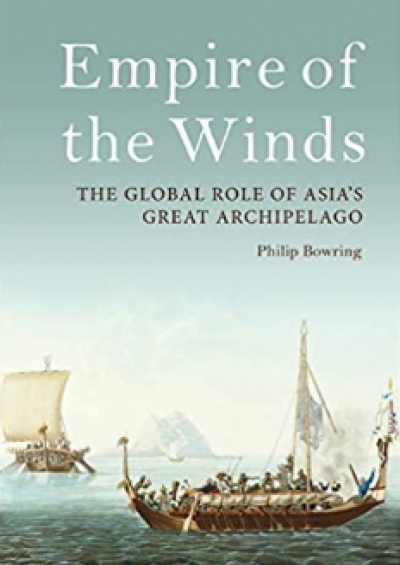Southeast Asia: The Silk Road and the Roman Route
The Silk Road’s historical importance has been vastly exaggerated. It was the sea that was the most important link between east and west.
May 5, 2019

In his recently published “Empire of the Winds: The Global Role of Asia’s Great Archipelago” Philip Bowring takes a longue durée look at the history of the region commonly known as “Maritime Southeast Asia.”
In the process, he points out important but barely known facts of this history and addresses the widespread misconceptions of those schooled in Euro- and Sino-centric narratives about Vasco da Gama and Zheng He.
This is the context needed to assess today’s issues of the South China and adjoining seas.
In this series of five articles for The Globalist, he points out some key themes and their relevance to issues today.
There must be a thousand books about the so-called Silk Road, a term normally used to describe the land routes between Xian and Constantinople through central Asia.
But as its latest biographer Valerie Hansen writes:
The ‘road’ was not an actual ‘road’ but a stretch of shifting, unmarked paths across massive expanses of deserts and mountains. .. The quantity of cargo transported along these treacherous routes was small.
The most active parts were within central Asia and to Persia and Arabia. In terms of volume of long distance trade, the sea has always been of vastly greater importance. According to one Roman estimate, it was twenty-seven times more expensive to move goods by land than by water.
In addition, land routes were more susceptible to wars and disorder. As for the so-called Silk Road silk arriving in Rome most likely came either from central Asia or India, not China.
Rome’s conquest of Egypt
Evidence of some trade between the Mediterranean, Egypt, the Gulf, India and eastward can be traced way back before the current era. But it was Rome’s conquest of Egypt that led to development of massive trade with India, with an estimated hundred ships a year with cargo capacity of 200 tons or more leaving the Roman red sea ports for Africa and India.
But this was not high value goods. Rome’s imports included special types of marble as well as spices, gems and other luxuries. Wine and glass were leading exports. The trade generated much tax revenue for the Roman treasury but a trade deficit also drained the empire of silver.
Indian traders at the time were already familiar with the Malay peninsula and Sumatra to the east, known as the land of gold, Suvarnabhumi in Sanskrit or Chryse to the Greek traders.
A first century document written in Greek referred to very large ships trading between India and Chryse. Ptolemy’s second century map, which served as the West’s main source of geography for the next 1300 years, clearly denoted the peninsula and some locations on it.
Romans also noted sailing “rafts,” a reference to the outrigger vessels common throughout the archipelago, and that the boats of the region were sewn – the planks joined together with fibers.
Arriving by sea
The first Roman known to have reached China arrived in 166 CE almost certainly by sea as he brought gifts of rhino horn and ivory. Another arrived by sea in 226 CE near Haiphong, Vietnam, then under Chinese rule and met the emperor in Nanjing.
Most likely they came by sea, from India to the peninsula, transited across it by land, and then proceeded via ports at the Mekong mouth and Vietnamese coast.
By then, Indian traders had long been bringing Hinduism, Buddhism and writing to the peninsula, and then on to Sumatra, Java, Cambodia and the central and southern coasts of Vietnam.
They also brought kingship ideas which helped state development. Among the first of those was Funan on the Mekong delta whose power extended to the northern part of the peninsula.
A third century Chinese envoy described its capital as a walled city with palaces and it used Indian style writing and gold and silver as currency.
Unlike the Indian-Roman trade there are no documents which give an approximation of the size of trade. But it certainly included bulkier items such as aromatic woods, metals and metal products as well as spice, incense, ivory and textiles – Indian cotton as well as Chinese silk, even horses.
China was the biggest single market, but the Chinese merchants themselves did not normally venture south. The dangers outweighed the profits if the foreigners would come to them. If they did so, it would have been on the ships.
Rome’s decline
Rome’s trade with the east declined with the empire. Meanwhile in the east it picked up driven, in part, by the development of direct sailing from India to Sumatra, Java and China via the Melaka strait.
This was highly seasonal, driven by the monsoon shift from northeast in winter to southwest. This gave huge importance to the ports on the east Sumatran and north Java coasts as intermediaries.
For most of the next thousand years between them they were the most important players in the seas between India and China.
Takeaways
The Silk Road’s historical importance has been vastly exaggerated. It was the sea that was the most important link between east and west.
The Silk Road was actually a stretch of unmarked paths across deserts and mountains. The quantity of cargo transported along these treacherous routes was small.
The first Roman known to have reached China arrived in 166 CE almost certainly by sea as he brought gifts of rhino horn and ivory.